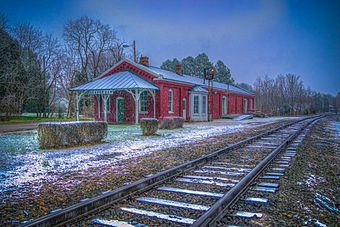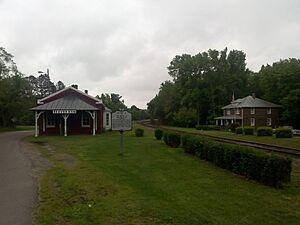Beaverdam Depot facts for kids
|
Beaverdam Depot
|
|

Beaverdam Depot in Winter
|
|
| Location | On C & O RR tracks at jct. of VA 715 and 739, Beaverdam, Virginia |
|---|---|
| Area | less than one acre |
| Built | 1866 |
| Architectural style | Late Victorian |
| NRHP reference No. | 88002060 |
Quick facts for kids Significant dates |
|
| Added to NRHP | November 8, 1988 |
The Beaverdam Depot is a historic train station located in Beaverdam, Virginia, within Hanover County, Virginia. It's a special old building that tells a lot about the history of railroads in Virginia.
Contents
Discovering the Depot's Past
The first train station in Beaverdam was built by the Richmond, Fredericksburg and Potomac railroad sometime between 1836 and 1840. This railroad line was very important because it helped farmers in Louisa, Virginia ship their crops to big cities like Richmond, Virginia and even to a port on the Potomac River. This helped the local economy grow.
The Depot During the Civil War
The Beaverdam Depot played a big role during the American Civil War. It was used to move soldiers and store important military supplies. Because it was so important, the wooden depot was destroyed and rebuilt at least three times during the war.
A famous event happened here on July 20, 1862. A Confederate soldier named John S. Mosby was captured by Union soldiers while waiting for a train. The Union soldiers then burned the depot to stop supplies from reaching the Confederates and cut the telegraph lines, which were like the internet of that time.
Rebuilding and New Beginnings
After the Civil War ended, much of the railroad was destroyed. But the Beaverdam station was one of the first buildings to be rebuilt. The current station, made of brick, was finished in 1866.
The railroad line kept growing and eventually became part of the much larger Chesapeake and Ohio Railroad system. Around 1910, a separate waiting room was added to the depot. This was because laws at the time required different waiting areas for white and "colored" passengers.
Looking at the Depot's Design
The Beaverdam Depot is a single-story building made of brick. It has a pointed roof and cool decorative brickwork, like patterns and columns made from bricks.
The front of the building has a small porch with a triangular top, supported by wooden columns. Inside, the depot still has its original layout. There were two waiting rooms (one for white passengers and one for black passengers), an office for the station master, a room for luggage, and a room for freight (goods being shipped).
The Beaverdam Depot was recognized for its historical importance and was added to the National Register of Historic Places in 1988.





